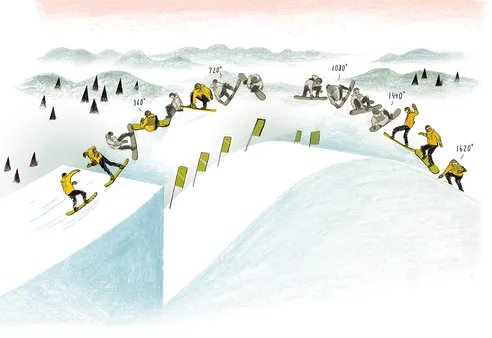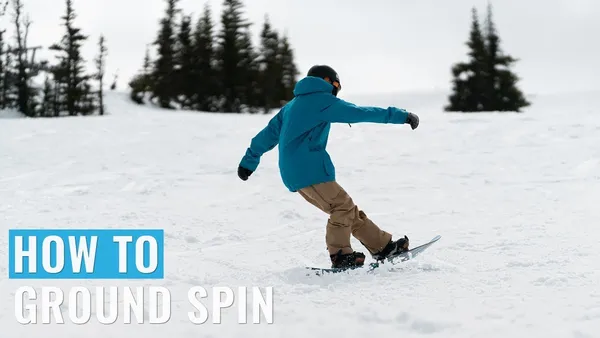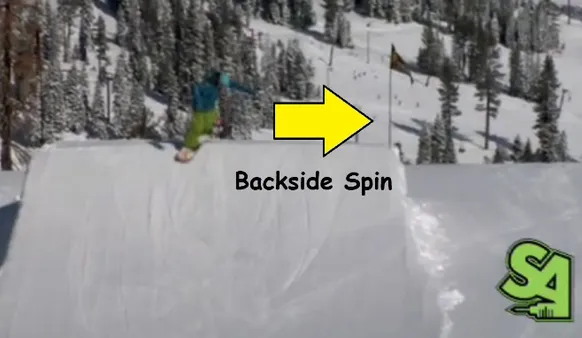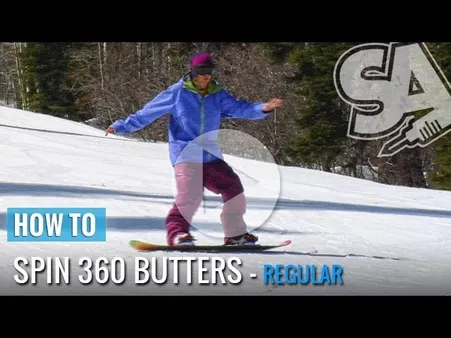Table of Contents
Are you ready to take your snowboarding skills to the next level and learn How to do a snowboard spin? Whether you're a beginner looking to try your first spin or an experienced rider wanting to expand your repertoire, Kizworld has got you covered. In this comprehensive guide, we'll break down the process into easy-to-follow steps, providing you with the knowledge and techniques you need to master the art of spinning on a snowboard. From choosing the right equipment to understanding spin mechanics and body position, we'll cover everything you need to know to spin with confidence and style. So, grab your snowboard and get ready to take your snowboarding to new heights with kizworld's guidance.
How to do a Snowboard Spin: A Comprehensive Guide for Beginners
I. How to Choose a Perfect Snowboard
How to Choose a Perfect Snowboard
The Right Size
- Your snowboard's length should come up to your chin or nose when standing it up next to you.
- The width should be wide enough to accommodate your boot size without any overhang.
- The shape of the snowboard will depend on your riding style and ability level.
The Right Flex
- A stiffer board will be more stable at high speeds and on hard-packed snow, while a softer board will be more forgiving and easier to maneuver.
- Beginners should typically choose a softer board, while more experienced riders may prefer a stiffer board.
The Right Camber
- Camber refers to the shape of the snowboard's base.
- A positive camber board will have a raised section in the middle, which provides good edge hold and pop.
- A zero camber board will have a flat base, which is more forgiving and easier to turn than a positive camber board.
For related reading on this, check out our post on How to choose the right surfboard.
The Right Tip and Tail Shape
- The tip and tail of the snowboard can be shaped in a variety of ways, each with its own advantages and disadvantages.
- A directional board has a longer nose than tail, which makes it more stable at high speeds and in powder snow.
- A twin tip board has a symmetrical shape, which makes it easier to ride switch (riding backwards).
The Right Bindings
- Bindings are what connect your boots to the snowboard.
- Bindings should be compatible with your snowboard and boots.
- When choosing bindings, consider your riding style and ability level.
For more information on this, check out our article on How to choose the right skateboard.
II. Mastering the Basic Snowboarding
Mastering the Basic Snowboarding
Mastering the Basics
Mastering the basics of snowboarding is crucial before attempting more advanced maneuvers. These fundamental techniques provide a foundation for safe and enjoyable snowboarding. This section delves into the essential skills you need to master, including proper stance, balance control, and basic movement techniques. These skills will help you navigate beginner trails and build confidence on the mountain.
Stance and Balance
- Stance: The stance you adopt on your snowboard directly affects your balance and control. Begin with a shoulder-width stance, with your feet positioned slightly angled outward. This stance provides a stable platform and allows you to distribute your weight evenly.
- Balance: Balancing on a snowboard requires practice and coordination. As you glide down the mountain, keep your weight centered over the board and your knees slightly bent. Maintain a relaxed and fluid stance, allowing your body to absorb bumps and changes in terrain.
Basic Movement Techniques
- Traversing: Start by practicing traversing across the slope. Push your weight in the direction you want to go and use your toes and heels to control your speed. As you become more comfortable, try traversing at different angles across the slope.
- Turning: To initiate a turn, shift your weight forward and apply pressure to the toe edge of your board. As you do this, twist your body and shoulders in the direction you want to turn. Use your arms to help guide the turn and maintain balance.
As you progress, you'll learn how to combine these basic techniques to perform more advanced maneuvers, such as carving, linking turns, and stopping. With regular practice and a focus on mastering the fundamentals, you'll be well on your way to becoming a confident and capable snowboarder.
How to Choose the Right Snowboard SpinHow to Master the Basic Snowboarding Skills
III. Choose the Right Clothing and Safety Gear
Choose the Right Clothing and Safety Gear 
When it comes to snowboarding, having the right clothing and safety gear is essential for a comfortable and safe experience. Here are some key items to consider:
- Snowboard Jacket: Look for a jacket that is waterproof, breathable, and insulated to keep you warm and dry on the slopes.
- Snowboard Pants: Choose pants that are also waterproof and breathable, with reinforced knees and seat for added durability.
- Base Layers: Wear moisture-wicking base layers to help regulate your body temperature and keep you dry.
- Helmet: A properly fitted helmet is crucial for protecting your head in case of a fall.
- Goggles: Goggles protect your eyes from the sun, wind, and snow, and they also help to improve visibility.
- Gloves: Waterproof and insulated gloves will keep your hands warm and dry.
- Boots: Snowboard boots provide support and control for your feet. Make sure to get boots that are the right size and fit.
- Snowboard: Choose a snowboard that is appropriate for your skill level and riding style.
- Bindings: Bindings attach your boots to the snowboard and allow you to control the board.
Item | Features to Look For |
Snowboard Jacket | Waterproof, breathable, insulated |
Snowboard Pants | Waterproof, breathable, reinforced knees and seat |
Base Layers | Moisture-wicking, regulates body temperature |
Helmet | Properly fitted, protects head |
Goggles | Protects eyes from sun, wind, and snow, improves visibility |
Gloves | Waterproof, insulated, keeps hands warm and dry |
Boots | Right size and fit, provides support and control |
Snowboard | Appropriate for skill level and riding style |
Bindings | Attaches boots to snowboard, allows control |
By investing in the right clothing and safety gear, you can ensure that you have a safe and enjoyable snowboarding experience.
For more information on choosing the right snowboard and equipment, check out our article on How to Choose the Right Snowboard for Your Skill Level and Style.
IV. Practice Safety
Practice Safety
When snowboarding, safety should always be your top priority. Here are some tips to help you stay safe on the slopes:
- Wear a helmet. This is the most important piece of safety gear you can wear. A helmet can protect your head from serious injury in the event of a fall.
- Dress in layers. This will help you stay warm and dry, which will make your snowboarding experience more enjoyable.
- Start on easy slopes. Don't try to tackle difficult terrain until you have mastered the basics.
- Take lessons from a qualified instructor. This is the best way to learn the proper techniques and avoid bad habits.
- Be aware of your surroundings. Pay attention to other snowboarders, skiers, and obstacles on the slopes.
- Don't snowboard under the influence of alcohol or drugs. This can impair your judgment and reaction time.
- Stay hydrated. Drink plenty of water throughout the day to stay hydrated.
- Listen to your body. If you're feeling tired or sore, take a break.
By following these safety tips, you can help reduce your risk of injury and have a safe and enjoyable snowboarding experience.
If you're new to snowboarding, it's a good idea to start by taking a lesson from a qualified instructor. This will help you learn the basics of snowboarding and avoid bad habits. Once you've mastered the basics, you can start practicing on your own. Be sure to start on easy slopes and gradually work your way up to more difficult terrain as you gain experience.
When you're snowboarding, it's important to be aware of your surroundings. Pay attention to other snowboarders, skiers, and obstacles on the slopes. Be sure to yield to other snowboarders and skiers who have the right of way. And be careful of obstacles such as trees, rocks, and moguls.
It's also important to stay hydrated when you're snowboarding. Drink plenty of water throughout the day to stay hydrated. And be sure to listen to your body. If you're feeling tired or sore, take a break.
By following these tips, you can help reduce your risk of injury and have a safe and enjoyable snowboarding experience.
How to Choose the Right Snowboard for Your Skill Level and StyleThe Benefits of Snowboarding for Fitness and FunThe Best Snowboarding Equipment and Accessories
V. Conclusion
As you continue to practice, gradually increase the size and complexity of your spins. Remember, patience and persistence are key to mastering snowboard spins. Don't get discouraged if you don't nail it right away. Keep practicing, learn from your mistakes, and most importantly, have fun! With dedication and practice, you'll be spinning like a pro in no time. If you're looking for more tips, tricks, and snowboarding advice, be sure to visit kizworld. We're here to help you make the most of your snowboarding experience.